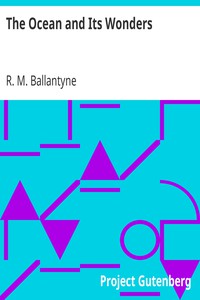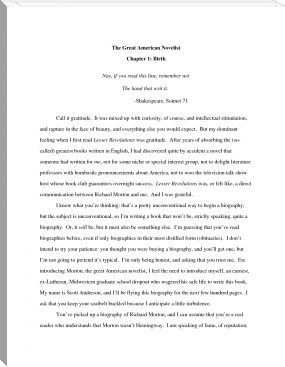The Ocean and Its Wonders by R. M. Ballantyne (free novel reading sites .TXT) 📖

- Author: R. M. Ballantyne
Book online «The Ocean and Its Wonders by R. M. Ballantyne (free novel reading sites .TXT) 📖». Author R. M. Ballantyne
The theory which we have ventured to propound in regard to vigorous impulse (whether of joy or fear) being the cause of eliciting luminosity, is supported in some degree by the remark in our last quotation, that when the bucket was sharply struck, there appeared at once a number of luminous bodies, which shone for a few seconds, and then disappeared. Undoubtedly the poor little things got a fright when their residence was sharply assailed in such an unusual manner; their energies were roused, and their light emitted. Then, as they gradually calmed down, their light disappeared.
We are further told that when a drop of sulphuric acid was put into a tumbler of water, “several bright flashes were seen.” This, we venture to think, was somewhat similar to the putting of a few drops of brandy and water into the human stomach; the usual result of which is, as we all know, to produce several bright flashes of wit, if not of light, or of something at least meant to be remarkably luminous!
But this luminosity is not entirely confined to the minute creatures of the sea. Some fish have the power of emitting light. Some species of the shark emit a greenish light; and the sun-fish is said, when seen down in the sea on a dark night, to glow like a white-hot cannon-ball. Fish when dead and putrid frequently glow in the dark with a truly magnificent light, as can be proved by every one who will take the trouble to procure several kinds of fish, and keep them, for the purpose of proving the fact, in a dark closet.
Of all the minute inhabitants of the deep, that which is to our mind the most curious, both as to its nature and its stupendous works, is the coral insect. This creature is much too important to be dragged in at the tail of a chapter. We will, therefore, commence its history in a new one.
Many of the large and beautiful islands that stud the Pacific Ocean, like emeralds in a field of blue, are artificial; that is to say, they were made by artists—they were actually built by artisans!
These artisans are the coral insects; and as they not only affect the face of the sea by raising large islands above it, but also, in consequence of their labours, assist in causing the circulation of the ocean, we think they are justly entitled to very special attention.
The great archipelago called Polynesia covers an area of the Pacific nearly 5000 miles in length, and not far short of 2000 in breadth. Some of the islands of this group are of volcanic origin, and some are crystal; but by far the greater number are of coral formation—the work of those curious little insects, which are so small that they inhabit a dwelling sometimes little larger than a pin-point.
The manner in which these islands are made is, to some extent, a matter of uncertainty. The most generally received opinion is, that the insects fasten round the summit of a submarine mountain, and build upwards until they reach the surface of the sea, where they die, and their labours cease. As, however, the sea is sometimes unfathomable close to those islands, it has been supposed that the submarine islands on which the corallines began to build have gradually subsided, and that, as they did so, the insects always built a little more, so as to keep the top of their structures on a level with the sea. Above the sea they cannot build. To be washed by the waves is essential to their existence.
We do not think this a very satisfactory theory, because it supposes a prolonged subsiding of these islands, and then an unaccountably sudden stoppage. For although the corallines might continue to build during the whole time of subsidence, it were utterly impossible that the coral island, with its luxuriant herbage, could be formed until that subsidence should have ceased. The manner in which the islands are formed makes this obvious.
When the coral reef, as it is called, reaches the surface, it advances no further. Soon the action of the waves breaks off the branches of the upper portions of coral, which are tossed upon the reef, and pulverised into fine sand. This goes on increasing until the island rises a little above the waves.
When this happens, birds alight there; sea-drift is carried thither; seeds are blown to it by the wind; and gradually a few green blades arise. From this little beginning it is easy to conceive the process by which at last a flourishing island springs up. At the same time, it is not easy to see how such islands could ever be formed on the supposition that the submarine rocks on which they were founded were perpetually subsiding.
But be that as it may, we have no difficulty in understanding the fact that the coral insect does build those islands. It possesses the power of secreting the lime held in solution by sea water, and depositing the same on the rocks below the waves. The coral rock is the edifice of the coralline. The insect itself is a soft and very minute worm, which, when washed by the waves, thrusts its head out of its tiny little door, and spreading abroad its numerous feelers, so that it resembles a beautiful little star, moves these about as if enjoying itself—though, doubtless, it is actually engaged in the process of manufacturing its little atom of coral rock.
It is extremely interesting to think of the immense power of union thus exhibited. Singly, those little creatures could not produce a sufficient result to attract the attention of any creature save such as chanced to come in direct and close contact with its little cell. United, they have formed vast islands, which have become the abode of man, and which, in the aggregate, form no inconsiderable portion of the globe.
The consideration of this leads us to perceive that God has ordained that units cannot, separately, accomplish much; and that united effort, in order to be successful, requires the harmonious action of units. “A house divided against itself cannot stand.” The innumerable and eminently beautiful isles of the Pacific had never stood where they now stand if the curious, and separately insignificant, little architects that reared them had not wrought unitedly upon a fixed and systematic plan—each insect working its utmost from the hour of its birth until that of its death.
There are various kinds of coral insects, which form varied species of coral rock. Some kinds of coral assume the form of rounded masses; some are like a branching shrub; others are in layers, or thin plates; and some are shaped like the human brain, from which they derive their name—brainstones. These different kinds differ also in colour, and thus present a beautiful appearance when seen at the bottom of clear and shallow water.
In regard to the rate at which the corallines build their cells there is some diversity of opinion—some asserting that the process is imperceptible, while others state as positively that it is rapid. There can be no doubt that some localities and positions are more favourable to the growth of coral than others. Dr Allan, while at Madagascar, made several experiments to test this. He selected several masses of coral, each weighing about ten pounds, and of different species. These he placed three feet below the surface of the sea, and staked them in to prevent removal. In a little more than six months they were found to have risen nearly to the surface, and to have attached themselves to the solid rock.
There is also a case mentioned of a ship in the Persian Gulf which, in the course of twenty months, had her copper encased with living coral to the thickness of two feet.
On the other hand, it is asserted, and we doubt not with equal truth, that many reefs do not seem to increase in size in the course of many years.
When a coral reef has reached the surface, the formation of an island instantly begins; but it necessarily takes a long time ere this island becomes habitable by man. Among the first plants that raise their heads to the sea-breeze is the graceful cocoa-nut palm. This tree is exceedingly hardy, and is found growing on reefs which are so low that at a distance the trees seem to be standing on the surface of the water. Indeed many of them spring out of the pure white sand, and their roots are washed perpetually by the salt spray. Nevertheless, the fruit of such trees is sweet and good.
Coral islands of the kind we have just described seldom rise more than a few feet above the level of the sea; but most of them are clothed with luxuriant vegetation.
We might easily fill a volume on the subject of the ocean’s inhabitants, small and great; but we think the few to which we have made reference is sufficient for the purpose of showing that one set of creatures accounts for that strange luminosity of the ocean which is seen at times in all marine parts of the globe, while another set accounts not only for the sudden appearance of coral islands in the sea where no such islands existed in days of old, but also, partly, for that circulation of the waters of the ocean which is absolutely necessary to the wellbeing of all the creatures on this earth.
There are other animals in the sea, besides medusae, which assist in giving luminosity to its waters; and there are other insects, besides corallines, which extract its lime, destroy its equilibrium, and assist in causing its perpetual motion; but the two species which we have described are the best types of the respective classes to which they belong.
In the last chapter we described the manner in which a certain class of islands in the South Seas are formed; in the present we will make a few observations on another class, which have sprung up from the bottom of the sea, as if by magic, under the irresistible influence of fire.
There are volcanoes in the sea, as well as on the land; and these volcanoes have in former times up-heaved huge masses of land so as to form large islands, while in other cases they have caused islands formerly in existence to subside and disappear.
In the writings of the ancients we find reference made to an island which, if it ever did exist, now exists no longer. It was situated opposite the Straits of Gibraltar, was nearly two hundred miles in length, and was called “Atlantis”—hence the name of the Atlantic Ocean. Many believe, and with some reason, we think, that this island was not altogether a myth, although much that is said of it is undoubtedly fabulous.
Plato tells us that it was a large island in the Western Ocean, situated before or opposite to the Straits of Gades; and that out of this island there was an easy passage into some others which lay near a large continent, exceeding in bigness all Europe and Asia. So far Plato may have told the truth, and from this passage it is conjectured that the existence of the continent of America was known to the ancients. But he goes on, immediately after, to draw upon his imagination,
 Have you ever thought about what fiction is? Probably, such a question may seem surprising: and so everything is clear. Every person throughout his life has to repeatedly create the works he needs for specific purposes - statements, autobiographies, dictations - using not gypsum or clay, not musical notes, not paints, but just a word. At the same time, almost every person will be very surprised if he is told that he thereby created a work of fiction, which is very different from visual art, music and sculpture making. However, everyone understands that a student's essay or dictation is fundamentally different from novels, short stories, news that are created by professional writers. In the works of professionals there is the most important difference - excogitation. But, oddly enough, in a school literature course, you don’t realize the full power of fiction. So using our website in your free time discover fiction for yourself.
Have you ever thought about what fiction is? Probably, such a question may seem surprising: and so everything is clear. Every person throughout his life has to repeatedly create the works he needs for specific purposes - statements, autobiographies, dictations - using not gypsum or clay, not musical notes, not paints, but just a word. At the same time, almost every person will be very surprised if he is told that he thereby created a work of fiction, which is very different from visual art, music and sculpture making. However, everyone understands that a student's essay or dictation is fundamentally different from novels, short stories, news that are created by professional writers. In the works of professionals there is the most important difference - excogitation. But, oddly enough, in a school literature course, you don’t realize the full power of fiction. So using our website in your free time discover fiction for yourself. 




Comments (0)